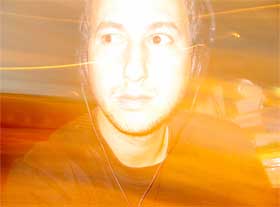 I’ve been following Jonah Brucker-Cohen interviews of artists on Gizmodo for months. As he’s one of the most talented artists of his generation, i thought it was high time to fire a few questions at him. Jonah is also a researcher, Ph.D. candidate, and HEA MMRP fellow in the Disruptive Design Team of the Networking and Telecommunications Research Group, Trinity College Dublin. He was a Research Fellow in the Human Connectedness Group at Media Lab Europe. He received a Masters from the Interactive Telecommunications Program at NYU and was an Interval Research Fellow there creating interactive networked projects. His research focuses on the theme of “Deconstructing Networks” which includes projects that attempt to critically challenge and subvert accepted perceptions of network interaction and experience (complete bio.)
I’ve been following Jonah Brucker-Cohen interviews of artists on Gizmodo for months. As he’s one of the most talented artists of his generation, i thought it was high time to fire a few questions at him. Jonah is also a researcher, Ph.D. candidate, and HEA MMRP fellow in the Disruptive Design Team of the Networking and Telecommunications Research Group, Trinity College Dublin. He was a Research Fellow in the Human Connectedness Group at Media Lab Europe. He received a Masters from the Interactive Telecommunications Program at NYU and was an Interval Research Fellow there creating interactive networked projects. His research focuses on the theme of “Deconstructing Networks” which includes projects that attempt to critically challenge and subvert accepted perceptions of network interaction and experience (complete bio.)
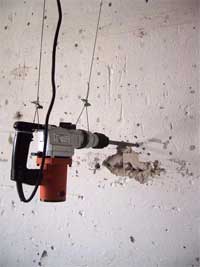 Jonah is now spending a few days in Montreal to prepare a solo show of 6 of his projects at OBORO which opens at 5 pm on September 16th. The link to the Montreal show is actively connected to his Alerting Infrastructure! project (image on the right) which will be set up inside the gallery until October 21. This physical hit counter translates visits to the webpage into damage of the physical gallery space.
Jonah is now spending a few days in Montreal to prepare a solo show of 6 of his projects at OBORO which opens at 5 pm on September 16th. The link to the Montreal show is actively connected to his Alerting Infrastructure! project (image on the right) which will be set up inside the gallery until October 21. This physical hit counter translates visits to the webpage into damage of the physical gallery space.
I seemed to bump into your installations, performances and talks all over Europe while you were in Dublin. What have you been doing since you left Europe?
I left Ireland in January 2005 and moved back to the US (NYC). Since I left I’ve still been active giving talks and workshops, in fact I’ve given twenty lectures about my work in 4 countries and also led nine workshops including three this summer and a few more scheduled for the fall. All of the workshops are in collaboration with Katherine Moriwaki. We have been leading our Scrapyard Challenge workshops at venues around the world since 2003. Since I moved back to the US, I have also shown work in 7 exhibitions in 3 countries and am gearing up for a solo show of my work in Montreal which opens Sept 16th. So I’ve been keeping busy, but it might seem like I have less of a European presence since I’m not living in Ireland anymore and haven’t gone to any of the major European media arts festivals since I moved home.
Is the US a more fertile ground than Europe for digital/interactive/new media art? Which differences did you perceive between both continents as regards the exhibition, financing, support and interest of your works and the one of fellow artists?
The main difference between European countries (and most other countries) and the US when it comes to art in general, is that in the US there is no public funding for art exhibitions, festivals, or even commissions. All of the art funding here comes from private institutions such as universities, foundations, or independent research organizations that are usually backed with corporate or philanthropic funds. As a result, there are less large-scale digital art projects than typically occur in other countries, however recently with events like the Year-01 festival in San Jose, South By Southwest, and the fluctuating media arts presence at the annual SIGGRAPH conference, the US is beginning to support larger projects that might eventually have the potential to change the federal government’s stance on supporting these types of endeavors. Institutions such as galleries or universities or other privately funded art and technology centers have supported most of the projects that I have participated in within the US.
Your work “critically examines and questions the proliferation of networked media.” What’s wrong with the proliferation of networked media?
My work examines the proliferation of networked media and experience in popular culture. I am particularly interested in how networks (such as the Internet and wireless networks) are represented and used in everyday life. My projects focus on this use and either challenge it by altering accepted systems of use or by creating new relationships to the ways in which we perceive networks through custom designed input and output devices along with heightening metaphoric relationships. There is nothing “wrong” with networked media per say, I am just trying to highlight the nuances and catch- phrases of networked culture by making its processes and relationships less transparent, and more blatantly obvious.
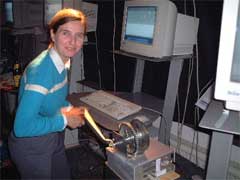 For example, my Crank The Web project is a physical manifestation of something usually transparent (the download speed of a typical network connection), which is an attempt to materialize this seeming “invisible” and vital component of network experience. Also, my BumpList project examines the governed rules and behaviors of online systems and how by changing these methodologies we can learn more about why they exist in the first place.
For example, my Crank The Web project is a physical manifestation of something usually transparent (the download speed of a typical network connection), which is an attempt to materialize this seeming “invisible” and vital component of network experience. Also, my BumpList project examines the governed rules and behaviors of online systems and how by changing these methodologies we can learn more about why they exist in the first place.
Let’s talk about one of the works you will be showing in Montreal at the Oboro Gallery. How does PoliceState work exactly? Do people intuitively understand what’s going on when they see the installation?
PoliceState is a Carnivore client. Carnivore was the third incarnation of surveillance software such as Etherpeek and Omnivore created by the FBI to snoop on data such as email, urls, Instant Messages, etc. sent through Commercial ISPs. PoliceState connects to the open-source version of Carnivore (which exists as a server and packet sniffer) developed by the NYC-based Radical Software Group and attempts to reverse the surveillance role of law enforcement into a subservient one for the data being gathered. The client consists of a fleet of 20 radio controlled police vehicles that are all simultaneously controlled by data coming into the main client. The project looks for packet information relating to international and domestic US terrorism. Once found, the text is then assigned to an active California state police radio code, translated to its binary equivalent, and sent to the array of police cars as a movement sequence. In effect, the data being “snooped” by the authorities becomes the same data used to control the police vehicles. Thus the police become puppets of their own surveillance. This signifies a reversal of the control of information appropriated by police by using the same information they gather to apprehend criminals but instead, uses it to control the police themselves. In the gallery, the PoliceState police cars are setup on a raised platform with a projection of the screen interface so that visitors can see the data being parsed in real-time through the network. For this particular installation I am using data gathered at local and International wireless hotspots as well as the traffic moving through the gallery’s local area network (LAN).
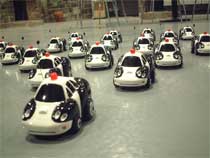
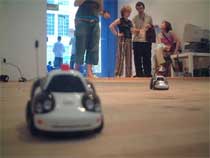 PoliceState
PoliceState
Whether your installations give a tangible presence to web-based elements or translate the physicality of the real world into the virtual, they always have a playful and humourous component. How important is humour in your work? How does it help to “get your message out in the world”?
Humor is a key ingredient in a lot of my projects. It is usually the best way to overcome any preconceptions of how to interact with technology and One of my projects in particular, IPO Madness examines the humorous side of the networked economy by poking fun at the surge of IPO destined companies that came out of the “Dot-Com” Bubble. By merging a slot machine with the act of generating website addresses, IPO Madness comments on the “E”conomy by combining the themes of “wasted consumption” and “getting rich quick” to annunciate this seemingly thriving condition among the Internet economy. This project is one of my only projects that really speaks to a specific era of Internet history, where anyone could receive venture capital funding for the most simplistic and banal dot-com company idea. In the current web 2.0 world, this is less relevant, but there is still a latent hope amongst those getting into the web-based technology services field that their company will either make millions by being bought by Google or Yahoo.
Another example of humor in my work is Crank The Web and BumpList: An Email Community for the Determined!. “Crank The Web” examines the transparent or invisible nature of bandwidth speeds and breaks down the costs of availability. The project consists of a metal hand crank that allows one to manually turn the crank to download a website. It adds a very physical component to the increasingly automated world of data retrieval and web-based interaction. Similarly, “BumpList: An Email Community for the Determined” is a typical emailing list with the constraint of only allowing 6 people to join the list at any given time. When a new person joins, they “bump” off the first person in the queue thus creating a revolving door type subscription policy for a widely used system of online interaction. The effect of changing one rule had a profound effect on the way people interacted with the software and caused them to react in very irrational ways as well as employing ingenious methods of trying to stay on the list. Overall, the result was very humorous since people had to invent really interesting ways of staying on the list when all else failed.
How do you finance your art works? Do you rely on grants? Commissions? Side jobs?
Some of my projects have been awarded grants such as SimpleTEXT from Low-Fi, an arts organization in the UK and Umbrella_net (in collaboration with Katherine Moriwaki) which won the Araneum Prize in Spain, and PoliceState was initially funded by the Dutch Electronics Arts Festival (DEAF), but most of them have come out of research projects that I have done while either an Interval Research Fellow at ITP (NYU) or a Research Fellow at Media Lab Europe in Dublin.
 Wifi-Hog
Wifi-Hog
What were you trying to achieve with Wifi-Hog? What do you answer to people who accuse you of having created a dangerous system?
The story behind Wifi-Hog is very complex, in fact there’s a link here to a longer article I wrote about the project that explains its intentions and the reaction it received by local community groups. Basically, the project started when I began to notice that there was a lack of an acceptable use policy surrounding the use of wireless or “wi-fi” networks in urban centers. In particular, there was an article in Slashdot from 2002 about a battle over public wireless space between a community wireless group (Portland Personal Telco) that had put up a free network in a public square and a Starbucks store that put up a “pay-per-use” network in the same vicinity. The end result was that the free community group network had to shut down because their signal was being drowned out by the stronger, Starbucks network. This got me thinking about how public space was beginning to be delineated by broadcast strength with the advent of Wi-Fi networks. Wi-Fi Hog exists as a tactical tool to liberate these pay-per use networks and hopefully let the free ones remain. Ultimately the project attempts to subvert claims of ownership and regulation over free spectrum, by allowing a means of control to come from a third-party.
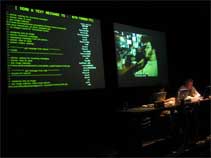
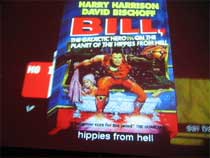 SimpleTEXTwith Tim Redfern and Duncan Murphy
SimpleTEXTwith Tim Redfern and Duncan Murphy
Do you develop your art pieces yourself from A to Z or do you rely on the cooperation with programmers or other technicians? How much doescooperating change your view on your initial idea?
In most cases I have developed projects on my own, but occasionally (such as in the case of BumpList, Umbrella_net, SimpleTEXT and the Scrapyard Challenge Workshops) I have worked with collaborators including other artists as well as some programmers and electrical engineers. I find that collaboration ultimately strengthens any project to the point where you begin to realize new angles and approaches with the work that you would have never discovered if you were working alone. This is a very important quality that has benefited some of my projects to no end. In the case of BumpList, my collaboration with Mike Bennett improved the project immensely because we worked together on finding interesting ways of improving the system and analyzing the resulting data gathered from its use. The SimpleTEXT collaboration with Tim Redfern and Duncan Murphy allowed the project to gain a lot more depth in both the musical output generated by incoming messages and the visuals created during the performance. Also, the Scrapyard Challenge Workshops (ranging in theme from MIDI Scrapyard Challenge to DIY Urban Challenge, to Wearable Challenge) that Katherine Moriwaki and I run together benefit immensely from collaboration because we both bring complementary and unique skill sets to the workshops that ultimately results in more interesting output by the participants.
Is there any researcher or artist whose work you find particularlyinspiring? Why?
In the eclectic world of media art, there are many artists that I admire and find truly inspiring. In particular, two artists come to mind that examine and question the fundamental relationships between technology and human interaction and experience. Danish artist Mogens Jacobsen‘s Crime Scene: An Installation For Two Computers is a really interesting take on the legalities of file sharing across the Internet. The project consists of two computers that are continuously swapping copyrighted material back and forth in a closed network. The whole installation is situated behind some yellow Police tape that says “Crime Scene: Do Not Cross”. These types of projects that directly address the medium in which they exist are really interesting to me because of both their simplicity as well as the fact that they question the fundamental culture of networks. I also admire Norman White‘s Helpless Robot, a robot with no moving parts that simply calls out for people in its vicinity to pick it up and move it. Helpless Robot adds humor and humility to something typically thought of as “high tech” and advanced such as a robot. So basically, my favorite art projects consist of those that challenge traditional relationships to specific technologies or break down and subvert typical experiences with everyday systems or networks.
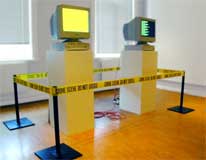
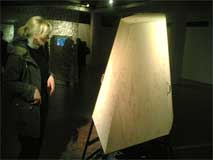 Crime Scene and Helpless Robot
Crime Scene and Helpless Robot
And now the question that traditionally ends your interviews of other artists for Gizmodo: What projects are you currently working on? How are they similar or different than your past projects?
I’m currently working on finishing my PHD, which focuses on methods of “Deconstructing Networks” by challenging existing frameworks of networked interaction and experience. I’ve been working on a few new projects that exist as extensions to other projects that I have already done. One project examines the proliferation of wireless networks in urban space and like my Wifi-Hog piece, also attempts to create a rift in the clash over public vs. private or pay-per-use wireless networks. Another project I’m working on is the next iteration of my BumpList emailing list project. The new version attempts to interject even more rule sets and constraints into these ubiquitous online communities by allowing for more control to come from the users themselves. In particular, one component of the system employs adaptive rules that change based on user behavior and involvement. Overall, I’m remaining within the same theme of networks but looking more closely at how and why these systems were developed and how changing them even slightly can often produce unique and varied effects.
The exhibition Jonah Brucker-Cohen – Deconstructing Networks opens at the Oboro Gallery (4001, rue Berri, local 301) in Montreal, on Saturday, September 16, 2006 at 5:00 p.m.
There will be a performance of SimpleTEXT with Tim Redfern“>Tim Redfern on September 16, at 3:00 p.m. Jonah Brucker-Cohen will also be giving a talk about his projects on the 11th at Concordia at 6:30pm.
